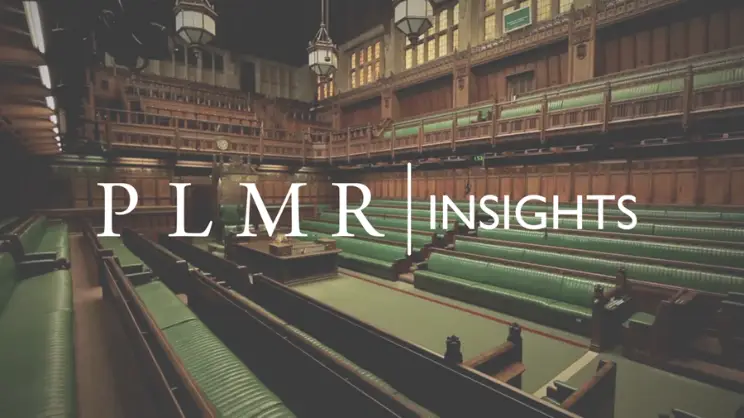Relevant Links:
• Government press release – https://www.gov.uk/government/news/government-unveils-levelling-up-plan-that-will-transform-uk
• White Paper in full –https://assets.publishing.service.gov.uk/government/uploads/system/uploads/attachment_data/file/1052064/Levelling_Up_White_Paper_HR.pdf
• Executive Summary – https://assets.publishing.service.gov.uk/government/uploads/system/uploads/attachment_data/file/1052046/Executive_Summary.pdf
• Scotland specific press release – https://www.gov.uk/government/news/uk-government-sets-out-blueprint-to-transform-uk
• PLMR Birmingham’s regional analysis – https://www.plmrbirmingham.co.uk/levelling-up-white-paper-what-it-is-what-it-includes-and-what-it-means-for-the-midlands/
Summary
The Government’s long-awaited 400-page ‘Levelling Up’ White Paper has been published this afternoon after months of delay. Pitched as the Prime Minister’s flagship policy, the idea has received a significant amount of attention since the 2019 election, yet for all the rhetoric around narrowing regional disparities, the concept has been criticised for lacking substance. Today’s publication aims to address that, and centres around 12 quantifiable ‘national missions’ the Government will aim to achieve by 2030. These are significant, and for the first time, establish actual metrics against which levelling up will be judged, allowing Parliament to clearly assess whether Boris Johnson has delivered on his promise, or fallen short.
These metrics are as follows:
1. Pay, employment and productivity will have risen in every area of the UK, with each containing a globally competitive city, with the gap between the top performing and other areas closing.
2. Domestic public investment in Research & Development outside the Greater South East will increase by at least 40% and at least one third over the Spending Review period, with that additional government funding seeking to leverage at least twice as much private sector investment over the long term to stimulate innovation and productivity growth.
3. Local public transport connectivity across the country will be significantly closer to the standards of London, with improved services, simpler fares and integrated ticketing.
4. The UK will have nationwide gigabit-capable broadband and 4G coverage, with 5G coverage for the majority of the population.
5. The number of primary school children achieving the expected standard in reading, writing and maths will have significantly increased. In England, this will mean 90% of children will achieve the expected standard, and the percentage of children meeting the expected standard in the worst performing areas will have increased by over a third.
6. The number of people successfully completing high-quality skills training will have significantly increased in every area of the UK. In England, this will lead to 200,000 more people successfully completing high-quality skills training annually, driven by 80,000 more people completing courses in the lowest skilled areas.
7. The gap in Healthy Life Expectancy (HLE) between local areas where it is highest and lowest will have narrowed, and by 2035 HLE will rise by 5 years.
8. Well-being will have improved in every area of the UK, with the gap between top performing and other areas closing.
9. Pride in place, such as people’s satisfaction with their town centre and engagement in local culture and community, will have risen in every area of the UK, with the gap between the top performing and other areas closing.
10. Renters will have a secure path to ownership with the number of first-time buyers increasing in all areas; and the government’s ambition is for the number of non-decent rented homes to have fallen by 50%, with the biggest improvements in the lowest performing areas.
11. Homicide, serious violence, and neighbourhood crime will have fallen, focused on the worst-affected areas.
12. Every part of England that wants one will have a devolution deal with powers at or approaching the highest level of devolution and a simplified, long-term funding settlement.
How does it intend to achieve this?
Although the Government has defined what ‘levelling up’ now means, questions remain over whether or not this is firstly deliverable, and secondly, ambitious enough.
Devolution – Decentralising UK Government and devolution are arguably at this plan’s core, with the document’s proposals representing the “biggest shift of power from Whitehall to local leaders in modern times”. The white paper invites nine English counties to apply for county devolution deals, including Cornwall and Durham. Some existing mayors will be offered further powers akin to those in London. According to the document, every part of England that wishes to have a ‘London-style’ devolution deal will have one. Despite being viewed as someone who wears his ideology lightly, something Johnson does believe in is devolution. This is arguably the biggest component of the strategy, and a new framework will deliver a ‘menu of options’ for every part of England, whether that is moving towards a London-style transport system to connect people to opportunity, improving local skills provision, or being able to act more flexibly and innovatively to respond to local need. This belief in the power of cities to generate growth is a constant throughout the document, and illustrates the Government’s desire to replicate existing pan-regional partnerships like the Northern Powerhouse and Midlands Engine, and local private sector initiatives.
New money? – Although the government has previously announced money to support its levelling-up agenda — such as the towns’ fund — the white paper is reliant on allocations in Chancellor Rishi Sunak’s spending review of last year. This has been portrayed by some media outlets and opposition parties as evidence of the plan’s lack of ambition. When this was put to Mr Gove on Sky News, he described the argument as “bogus”, citing the “huge cheque in the spending review” delivered by the Chancellor.The absence of any new money isn’t something the Government is trying to conceal either, and in the press release, outlines that “resources, energy, and focus throughout the 2020s will be re-oriented”, suggesting the missions will be driven by devolved policy levers rather than simply greater investment. With that being said, concerns have been raised around adequacy of previously announced pots of funding. Last week, the Treasury Select Committee raised concerns about the British fund for regional development, concluding that it fell £1 billion short of what the U.K. received from the EU. Meanwhile, analysis by the Guardian suggests that some of the wealthiest parts of England, including areas represented by Government ministers, have so far been granted 10 times more money per capita than the poorest under Boris Johnson’s administration.
Accountability – To ensure the Government isn’t marking its own homework, new legislation will be introduced, obliging it to publish an annual report updating the public on the progress of these missions, with a new Levelling Up Advisory Council including members such as Sir Paul Collier, renowned economist at Oxford’s Blavatnik School of Government, providing further support and constructive analysis.
Next steps – In their briefings to the media, the Government have been keen to manage expectations, highlighting that today’s publication isn’t a panacea to all of the country’s problems, but an overarching framework that will guide policy decision-making over the next few years. The paper’s conclusion describes the paper as “a critical stepping stone”, and in the short term, expect a comprehensive process of engagement across the whole of the UK on the proposals, as well as new legislation to put key elements of this programme in statute.
Implications for organisations wanting to engage with Government – For businesses, trade bodies, and charities looking to engage with Government, the White Paper offers an excellent opportunity. According to the publication, the UK Government will put in place a comprehensive process of engagement and informal consultation to inform delivery and future policy-making, and avoid the siloed, short-term and small-scale approaches that have hindered attempts to tackle disparities in the past.
This will include:
a. A structured process of visits, at ministerial level, across the whole of the UK in the months following publication of this White Paper, to discuss how levelling up can be successfully achieved in that area and to gather feedback;
b. An ongoing, long-term commitment for further ministerial visits across the whole of the UK, to update on progress on the policy programme and missions;
c. Setting up local panels, drawn from a wide range of stakeholders, to serve as a sounding board on levelling up delivery and implementation, working closely with the new Levelling Up Directors once established;
d. Annual reports summarising the key messages from these local panels, which will feed into the UK Government’s Cabinet Committee on Levelling Up;
e. An online space where local ideas, proposals and initiatives around levelling up can be heard and co-ordinated, to spread knowledge and understanding of what has worked locally and to foster innovation and experimentation.
Labour’s response
Following a statement to the House from Michael Gove, his Labour shadow Lisa Nandy delivered her response, asking “is this it?”, and asking why the “sum total of the UK’s ambition is a history lesson on the rise of the Roman Empire”. Despite failing to oppose any policies explicitly, she was scathing in her general criticism, calling the document “a shopping list of recycled policies”, that amounted to no more than “reshuffling the deckchairs”. In commonly levelled criticism, Nandy also asked where this government had been for the past 12 years, accusing it of creating the very problems it now purports to be solving, alluding to the austerity introduced by David Cameron and George Osborne in 2010.
Nandy was also critical of the so-called 12 missions, saying they equated to “12 admissions of failure”. She also criticised the process through which funding is allocated, saying it wasn’t right for the Chancellor to sit in Whitehall and draw lines on a map, and instead asked for genuine powers that would grant regions more autonomy. In her concluding remarks, Nandy said the Government could never be trusted to solve the problem of regional disparities, and accused them of not genuinely believing in the ‘levelling up’ agenda. Alex Norris, shadow minister for levelling up, housing, communities and local government has set out Labour’s vision for the White Paper here.
Analysis
Today’s document undoubtedly makes considerable progress towards adding meaning to the phrase ‘levelling up’. It’s taken two and half years, but we now have a set of clear metrics against which this project can be judged, and therefore, an understanding of what the much-repeated slogan means in practice and is expected to deliver
In a sentence, this strategy can be described as paving the way for more Londons to emerge. However, whilst the Government has expressed a willingness to afford other cities the same autonomy as the capital, it remains to be seen if they’ll receive commensurate levels of funding.
The other unknown is whether the Government has the ability, focus, and cohesion to deliver these ‘missions’. There is a significant risk its ambitions are cut short by ‘partygate’, or limited by Southern MPs in established Conservative seats, many of whom feel their constituents have little to gain from these policies and that levelling up the North means levelling down for them.
A cynic might say that this is why the Government has avoided setting targets ahead of the next election, but instead, opted for 2030. Devised with political expedience in mind, this suggests Johnson is aware of the difficulty he’ll face in keeping his electoral coalition happy, and set a course for a more gradual process spanning two General Elections. The flip side to this of course is that it will be difficult to measure progress at time of the next General Election. This is is a political risk as people who voted Conservative in 2019 on the back of promises of levelling up will likely want to see and feel tangible and meaningful improvements to their everyday life by that point.
Successfully navigating these challenges and backing this framework up with the required investment will ultimately determine Johnson’s legacy, and whether this White Paper is a stepping stone to narrowing regional disparities, or merely another government tome that’s forgotten about in 5 to 10 years’ time.




